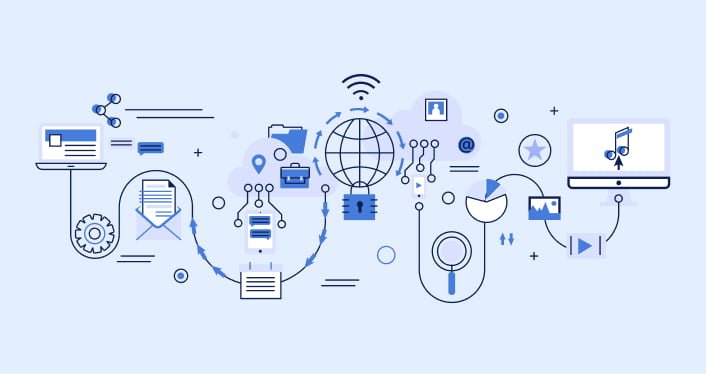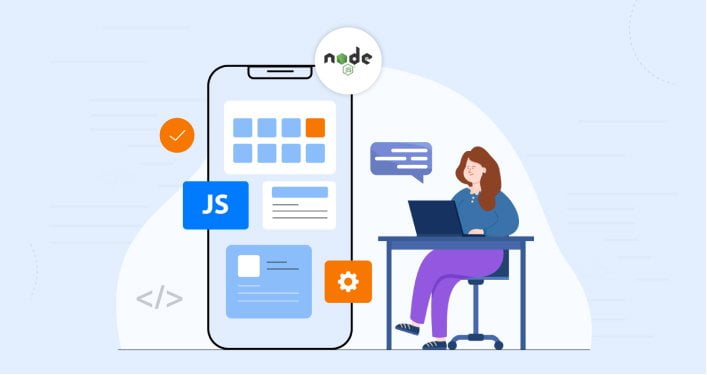Problems Encountered:
Scalability
The biggest difficulty that development teams have when creating real-time web apps is scaling. A complete set of SQL queries are required for each request of a refreshed query every four seconds. With 15 users, everything functions well; but, with thousands of users, it breaks down. Additionally, it’s crucial to think about the appropriate technology for your project. The data stream, notifications, and integration points must be designed from a scalability viewpoint by the developers.
Many large businesses may find scalable solutions with Node.js. For instance, Netflix LinkedIn has 221 million users worldwide. Node.js was chosen by the team because of its flexibility and scalability, and it turned out to be the best choice for them.
Safety
The safety concerns of the entire process must be taken into account while using real-time online streaming technologies. For instance, in order to provide SSO (Single Sign-on) and regulate access to information and systems depending on the user’s job, webcasting apps must interact with current safety levels.
The solution should also provide intellectual property security for algorithms and information privacy, particularly encrypting data both at idle and in action. If techniques are available on a cloud platform or are being used by network edge, it might be difficult. It’s because numerous solutions employ scripts or individually packaged routines to operationalize algorithms.
Ideal development frameworks
Streaming is usually done in real time. Dynamic data processing is just one part of the capability of real-time programmes. This streaming data eventually makes its way to a sizable data source, either on-site or in the internet. It is used by experts and subject matter specialists to derive insights, comprehend patterns, and create real-time methods that are applied to streaming data to improve operations and derive business value. The format of the information and the tools that analyzers, scientists, and subject matter experts have access to can influence how the platform is used and adopted as a whole.
A string of single-time data packets makes up data streams. Developers must therefore look for solutions for handling data information. It is simple to organise, display, and investigate patterns in this way. Additionally, the development framework offered by these tools is crucial for the streaming procedure. It can improve effectiveness and reduce error-proneness in the creation and distribution of methods to the OS.
It is better to employ system simulation tools to produce simulated data, which is used to complement actual data in building algorithms, rather than having to construct expensive planned maintenance methodologies.
Node.js for Back-end:
HTTP does not offer real-time web functionality. As it is crucial to maintain the connection, it cannot be neglected that each visitor requires a dedicated memory. So, the solution has to be chosen wisely.
To help this out, node.js becomes the powerful back-end tech suitable for all real-time applications. A single-threaded event loop is used by Node.js, which also makes event-driven programming on the server viable for a large developer community. The numerous advantages of node.js make it ideal for the back end of real-time apps.
It is Scalable
The key reason for using Node.js in web-based applications is to enhance the service and reduce system failure. The tolerance capacity of node.js helps the application manage the load. Node.js works on the V8 engine which makes it one of the finest solutions for large enterprises. It can easily handle huge traffic maintaining its speed.
Web applications like live TV or live sports have a large number of real-time users to watch their favourite events anytime and anywhere. They prefer watching without any interruptions and with the highest speed. Thus, these applications need a continuous response. Node.js aids in the development of event-driven functionality and non-blocking I/O.
When a request is received in a real-time app, such as a live tv app, a response is sent and the programme continues to serve requests because the asynchronous request processing methodology of node.js enables requests to be handled without blocking. Node.js excels in this area by using single-threading, resulting in fast response times and simultaneous execution.
Node.js provides a standard way for balancing connections by distributing load known as load balancing in the solution of managing a large number of incoming connections. The app instance is duplicated to manage multiple connections on a network of multiple servers.
Single Code
Using Node.js gives programmers the ability to create code on both the client and server sides, which is its strongest feature. Due to the lack of conversion needed, it also facilitates quicker data transmission between both the client and the server. This makes it easy and fastens code deployment and execution. As a result, it aids in faster data management.
Node.js may also be used to build bots and videogames apps due to its ability to manage multiple users. These services are powered by Web Sockets. Between the user and host, there is a two-way communication link using an easy technique that enables the sending or receiving data.
This can be easily explained with real-time applications like apps for retail, food delivery or transportation. These applications need quick and real-time notifications showing the status of the order and communication between both the service providers and the clients. Here, node.js helps in sending real-time notifications and sustaining the client and server connection.
Helps in online data streaming
Due to its efficiency in handling I/O requests, it helps in online data streaming. Multiple processes are being performed just on stream at once, which significantly reduces processing time. As a result, Node.js is a good choice for live streaming services.

It is Very Flexible
To search via databases, the backend uses NoSQL. As a result, developing a backend in Node.js spares the developer from having to modulate grammar variances. It also allows the queries to run without any problems with data conversion. It only creates additional opportunities for development rather than making it more useful and scalable.
Shortened response time
Because it makes it simple to handle more simultaneous incoming requests without adding additional threads Citibank, a well-known bank has been using several benefits of Node.js in terms of response time reduction.
Used by leading companies
Many leading companies have been using node.js as technology in the real world to to develop modern and flexible real time applications.
Uber
Uber has to make an investment in a dependable system for its users and its drivers because of the growing demand for on-demand taxi services. Due to its potential to complement its business requirements and enhanced data processing capabilities, Uber decided to construct a massive matching system using Node.js. his is where Node.js excels, enabling rapid code deployment, reliable processing of enormous volumes of data, and ongoing technological advancement. In present, Uber has the capacity to handle over 3 million online tasks.
PayPal
The client side of PayPal’s web application is created using Node.js allowing online transactions over 100 currencies. As node.js was adopted, using JavaScript, for both the front-end and back-end gave the solution to the developers for the problem of using the same language for server and client. It decreased the average response time and processed double requests per second.
Netflix
Netflix was founded on the foundation of Node.js technology and is best recognized for being the inventor of streaming services to over 182 million users. Node.js was used to have a common language for the server and browser sides. Also, it was chosen due to its light weight, flexibility and quick response time.
Other than these many famous apps like Trello, NASA, LinkedIn, Walmart, Twitter, Yahoo, eBay, and GoDaddy uses node.js at different stages of development.
Importance and uses of Socket.io
The remedy is offered by Socket.io. It allows the server to communicate data to the client at any time without the need for a prior request from the client. The server and client Socket.io library make it simple to produce Sockets. It is a fantastic tool for developers that wish to create client-server two-directional socket links. It greatly simplifies the implementation of straightforward apps like live chat.
SPA
Instead of loading an entirely new page, such an app constantly updates the existing web page in Single page Applications also known as SPA. Users may therefore have a comparable experience to one of a desktop programme. They are commonly utilised in the development of applications for social media and task control systems. Google and Gmail are famous SPAs. Because it is lighter, a lot of the work is done on the server instead of calling data directly to and from the client. In essence, it comprises only one page that includes all of the first received material.

Gaming Applications
A scenario for Socket.IO is a gameplay app involving more than two players. You won’t be able to develop any collaborative gaming applications or applications that need real-time communication with a server using simply HTTP programming. Due to their larger data packet sizes, HTTP and HTTPS calls cannot be made to create a real-time multiplayer gameplay application. The Socket.IO library is recommended in these instances for sending and receiving data from and to the host. Its quick and can only send the necessary datagram.

Chatting Applications
In the real-time chatting application, if one user let’s call it S is typing and wants to send a message to another user ‘JM’ then the first thing should be that ‘JM’ must know ‘S’ is typing. This is what defines as a real-time chatting application. Due to the latency, the other user ‘JM’ would never know the S’s status if we utilise HTTP calls in such applications. Using Socket.io, whenever user ‘S’ writes something, the gadget would only transmit a single data packet, informing the server that the user is typing. It will thus be supplied to another user, ‘JM’.
To put it simply Socket.io allows the client to be notified when the server gets a new message. The overall task accelerates and minimises data transmission while creating real-time messaging services with Socket.io.

Video Calling Applications
For creating apps for video callings, meetings, and video conferences, Node.js is a fantastic option. WebRTC helps in making audio, video and data communication between users better. SRTP, the safe and secured variant of RTP, is used by WebRTC to receive and send data via the internet using well-known VoIP mechanisms. It is a bit more difficult to interact with WebRTC if you already have a VoIP service implemented since it uses some small changes to SRTP that were not previously widely used.

Streaming Platforms
Node.js is an excellent choice for creating streaming apps. Streams and videos often operate together. Simply put, a backend sends a clip in a series of smaller bits rather than the complete thing at once. The entire movie is then sent. Because it only shows the portions it has already received and tries to load new, media buffers when being viewed on a sluggish connection. Users are able to process the data even as they are still being uploaded.
User Engaging Features
If you don’t provide such an experience, you will fall behind your competitors as a real-time app creator. We’ve put up a few key features to improve your customer experience and offer you an advantage over your competitors.
1. Real-time Talk
No matter the industry—healthcare, travel, or on-demand apps—real-time chat or texting is a necessary element. This function enhances web applications and meets users’ needs. This feature’s main strength is that it enables instantaneous collaboration between several users, which makes it a true achievement.
Quick chatting, several group conversations, phone and video calls, and video/voice messages are all included. The basis of real-time applications that allow users to transfer all kinds of documents and data is this essential fundamental characteristic.

2. Alerts
Because it enables consumers to be alerted whenever something interesting for them has occurred, notifying is a crucial component of real-time applications that must be integrated. Briefly said, it alerts customers to significant events, invites them back to the facilities, and motivates them to utilise them repeatedly. An intriguing truth is that if in-app alerts are used inappropriately, users may be persuaded to stop using the app.
In-app alerts display within the applications and are visible only if the user has them open. They work best for boosting usage statistics and app engagement. Push alerts, on the other hand, often display outside the app, irrespective of whether the app is open or not. In an app, messages have several advantages, including improving user experience, increasing app interaction and conversion rates, and monitoring user data.

3. Co-operating
Enhancing and automating operations involving numerous people is a requirement for real-time technology. Google Excel is a tool for producing documents. Cooperative applications unquestionably help businesses save a massive amount of time. A wonderful example of a multi-user collaboration tool is Google notes, which allows several users to edit or comment simultaneously.
One example is a real-time modification of documents. Real-time data transmits updates in data to an app quickly, updating users on any developments. Moving between stages in a process, for example, quickly displays progress in project management applications like Jira, leading to dialogues or the following phase in the workflow.

4. Live Stream
A lot of applications that employ live streaming include games online, on-demand ride-sharing services, real-time stock trading, and retail stock management. Live streaming offers a constant stream of data that can be accessed without first having to download it, which benefits industries including trade, property investment, entertainment, and transportation. Since this functionality enables an app to concurrently produce and distribute content to end-users and facilitates deeper user engagement, live streaming is extensively employed in numerous fields, including social networking.
For example, Weverse, VLive, etc are popular live applications that allow users to engage with their followers live, watch live broadcasts and send comments live.

5. Order Tracking
To keep track of shipments and orders in real-time, on-demand delivery and transportation apps must have a live order tracking functionality. The success of this function among consumers contributes to closing the insecurities that exist between clients and delivery services. This essential feature will help businesses who seek to build trusting relationships with their clients.
For example, Nykaa provides in detail tracking of the ordered products from it in a way that when and from where the item is picked up, where it reached, out for delivery, delivered, return applied, etc.
In a nutshell
There are several ways to use Node.js in real-time apps, including establishing a server connection between two devices, processing data on the server, and sending notifications to connected devices when it changes. Finally, when looking for a team of Node.js experts for the development of real-time applications, there are three key factors to keep in mind: technical skills, experience level, and management skills.
There are several ways to use Node.js in real-time apps, including establishing a server connection between two devices, processing data on the server, and sending notifications to connected devices when it changes. Finally, when looking for a team of Node.js experts for the development of real-time applications, there are three key factors to keep in mind: technical skills, experience level, and management skills.
There are several ways to use Node.js in real-time apps, including establishing a server connection between two devices, processing data on the server, and sending notifications to connected devices when it changes. Finally, when looking for a team of Node.js experts for the development of real-time applications, there are three key factors to keep in mind: technical skills, experience level, and management skills.
Conclusion
Hiring a company or freelancer is dependent on the type of the project, budget, and timeframe needed for the project development.
On long-term basis, for quick, personalized, proactive and cost-efficient service, hire a development company, and for independent requirements hire a freelancer; as per one’s preference. Even in small projects companies play a vital role by providing quality customizable packages.
FAQs
Where to build a serverless real-time data processing app?
How much does it cost to build real time candlestick charts app?
How much time does it take to build real time translation app?
Which are the latest popular live streaming apps?
Which API require to build real-time location tracking app?
Shivangi is a passionate Copywriter at Alian Software with expertise in technical copywriting. She shares information that is easy to understand regarding business, technology, and trends.